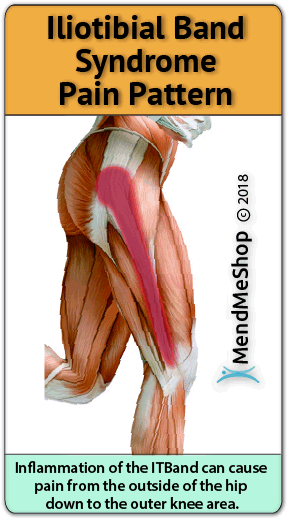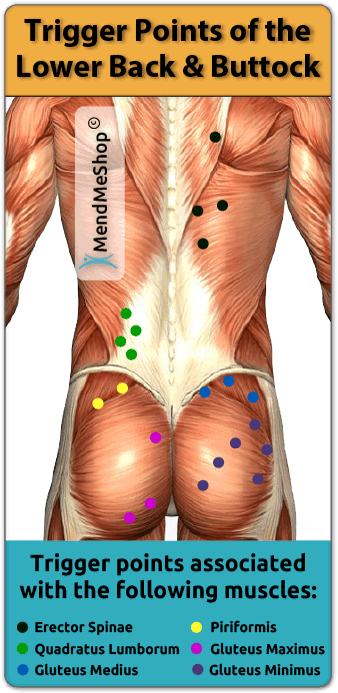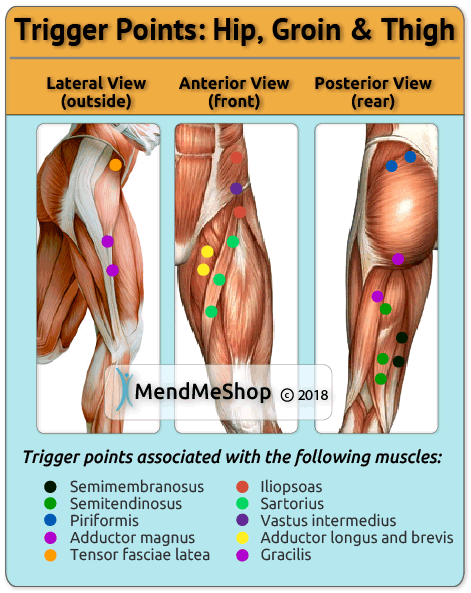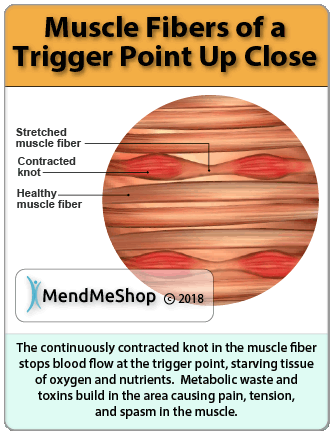Trigger points are specific, hyper-irritable and hypersensitive areas in muscle that cause the muscle to suffer from decreased blood circulation, increased contraction and spasm, and a build up of toxins and waste. Lack of circulation creates a high level of toxins and increased nerve sensitivity which can range from a low ache to a sharp pain. In the case of trigger points in the hip, just because the trigger point causes the pain does not mean that the location of the trigger point itself is painful. When the pain is located at the tense muscle spot, it is called a primary trigger point. However, pain can also manifest itself in areas away from the active trigger point - such pain is called "referred" pain. It is important to treat the trigger point that causes the referred pain and not the location of the pain itself.


It is said that trigger points cause pain more often than any other condition and are drastically under-diagnosed due to lack of information. Trigger point pain is usually a factor in most injuries although treatment of the trigger points are often overlooked. A common condition related to triggers points is known as myofascial pain.
A significant trigger point nodule can often be noticed as a small lump in the muscle, usually no larger than a pea. Less substantial trigger points are not so noticeable by a lump, but are easy to find anyway - just search your own muscles for the spots that feel most tender; they will transmit pain when you press on them. You may not be able to locate a trigger point by feel, but it will always hurt when you press on it.
Healthy muscle fiber is neither contracted nor stretched when at rest. When contracted the muscle fiber is closer together and when stretched, it's further apart. In a muscle that is causing trigger point pain, the fiber develops a knot and is in a constant state of contraction. The fiber around these knots is stretched by the excess tension and the muscle fibers become tighter. With the continuous contraction, blood flow is slowed to a stop in the trigger point area and essential oxygen and nutrients are prevented from reaching the muscle tissue. Toxins and waste build up in the muscle and you will experience pain, tension, irritation, and spasm.
It is not uncommon to find a "taut band" of muscle stemming from an advanced trigger point; this taut band will feel much like a small cable. These taut bands extend from the trigger point outward and can be mistaken for a tendon, and it is these taut bands, brought on by trigger points, that keep your muscle in a state of tension. Taut bands that are found in hip, lower back and thigh muscles are directly attributable to lack of hip movement. The bad news is that left untreated, the trigger point will worsen and the taut band will become more taut, freezing up your hip and lower back more and more. To free up your mobility, it is hugely important to:
The fiber around these knots is stretched by the excess tension and the muscle fiber becomes tighter. With the continuous contraction, blood flow is restricted in the trigger point area and essential oxygen and nutrients are prevented from reaching the muscle tissue. Toxins and waste build up in the muscle causing you pain, tension, irritation, and spasm.
The trigger point will usually become more tender or sting when you push on the spot and the referred pain will increase in intensity. Other symptoms include:


Tender trigger points typically develop from lack of stretching or improper stretching but can also be caused from stress/trauma, overuse or overburdening of a muscle and poor posture. Other common causes are:
Reduced circulation in trigger points will eventually lead to muscle shortening and restricted movement which further accentuates the pain, thus completing a cycle of decreased mobility and further pain. This commonly becomes the underlying cause of chronic hip pain and tight hip flexors, and the patient will continue to suffer from these until the problem trigger points are treated directly.


Mild Trigger Points can be addressed sometimes through massage and some sufferers maintain that acupuncture treats these problems as well, though it is not accepted by many medical institutions. Permanent removal of chronic trigger points and conditions caused by this, typically requires treatment using Circulatory Boost.
Within the physical therapy arena, one of the classic resources for Kinesiology (the study of movement and the way muscles cause movement to occur) reference is Brunnstrom's Clinical Kinesiology (Smith, Weiss, and Lehmkuhl 1996); much of the following information on this page will stem from this book. Though much of Kinesiology is focused on movement, it is also concerned with the myriad of factors that limit the function of muscles.
As you may or may not know, many hip problems will occur because one or more of the many muscles associated with the hip and lower back are not functioning properly. Trigger points within the muscle tissue affect muscle function negatively, and the most important effects of trigger points are as follows:
The reality about muscle and tendon injuries is that they often start slowly and gradually worsen to the point where the pain from the injury reduces your range of motion, eventually "freezing up" the joint. Once the hip becomes more and more immobile, adhesions start to develop essentially locking your hip into place. In the opinion of some doctors* the first step in treatment is to get rid of the trigger points that reside within the muscles associated with the hip. The sooner the trigger points are treated, the better chance there is to keep adhesions from forming.
If you have pain in your hip, buttock, lower back and thigh caused by tense, constricted muscles - use a TShellz Wrap® for your trigger points. Trigger point pain is caused by constricted muscle fibers that form knots, and eventually cause a buildup of toxins in the area. The trick to getting rid of this pain is loosening the knots to release the constricted muscle fibers. This will allow blood to flow through the fibers once again, bringing the vital oxygen and nutrients required for healthy tissue. An effective and pain-free way to loosen the knots is via Circulation Boost through use of a TShellz Wrap.
In addition, you want to get your muscle tissue back in the best possible condition you can. To do this, it is important to treat the scar tissue that forms in the muscle when the damaged tissue begins to heal - which is why we recommend use of the TShellz Wrap®. Even with optimum healing, there is always less elasticity in previously injured muscles fibers.
There are tools that can help treat your hip muscle trigger point pain and speed up the healing process so you can get back to a life without further pain. A TShellz Wrap treatment is intended to loosen knots at the trigger points, treat scar tissue, and promote blood flow to loosen constricted muscles while boosting your body's ability heal the fibers faster and more completely.
If you have inflammation, use a Cold Compress or Ice Pack to bring down the swelling. Once the inflammation is reduced, nourishing and strengthening the muscle tissue and surrounding area is recommended which can be achieved through use of the TShellz Wrap®
The hip naturally receives a limited blood supply and when you stop moving your leg and hip because of the pain, the blood flow is reduced even further - limiting your body's natural ability to heal itself.
By treating your hip and thigh trigger points with Circulatory Boost you can increase your body's blood supply to the muscle fibers and increase your body's natural healing power.
With a TShellz Wrap® application, tissues are safely and gently stimulated. Your body responds with a rapid increase in blood flow to the area, increasing the supply of oxygen and nutrients to injured tissue to promote the body's own recovery process. Our Back/Hip TShellz Wrap® provides effective, non-invasive, non-addictive pain relief, inflammation reduction and an enhanced blood flow with no side effects.
Improved blood flow whisks away dead tissue and toxins that have built up over time in your trigger point location. When you stop moving your hip and leg due to pain, your muscles and other tissue can become weaker, circulation drops, and dead tissue and toxins in the area build up, leading to further tissue deterioration - this can lead to atrophy. By clearing the area of toxins and increasing the amount of oxygen and nutrients to your muscle and other tissue, the risk of atrophy (muscle weakness and/or deterioration) is greatly reduced. Keeping your leg, hip, and buttock muscle tissue as healthy as possible throughout the healing process will allow you to improve hip strength and flexibility once your pain has gone and your trigger point pain has healed.
We've helped thousands of people treat their painful injuries and conditions to get them back on the road to a pain-free life!
Our customers have tried other common hip treatments, such as anti-inflammatory injections, pain killers, physical therapy, NSAIDs, and simply staying off their feet to give their hip the rest it needs, all without lasting results - until they found our incredible therapies! In addition, our customers include physicians, professional athletes, sports trainers and coaches, physical therapists, and nurses. These professionals rely on products from MendMyHip to treat their patients, players, and themselves. Click here to read more about their experience with MendMyHip!
Living with pain is never easy and we encourage you to call us with any questions you have related to your knee injury. We will do our best to help.
Product Advisors are available 9:00 am to 5:00 pm Eastern Standard Time Monday to Friday.
I want to learn more about Hip Surgery & Post-Surgery Recovery
I want to learn more about Circulation Boost
I want to learn more about Ice & Heat: Which Is Better For The Hip?
I want to learn more about Trigger Points in the Hip
I want to learn more about Hip Surgery: Do I Need It?
During your recovery, you will probably have to modify and/or eliminate any activities that cause pain or discomfort at the location of your soft tissue injury until the pain and inflammation settle. The more diligent you are with your treatment and rehabilitation, the faster you will see successful results!
Please be aware that this information is neither intended nor implied to be a substitute for professional medical advice. CALL YOUR HEALTHCARE PROVIDER IMMEDIATELY IF YOU THINK YOU MAY HAVE A MEDICAL EMERGENCY. Always seek the advice of your physician or other qualified health provider before using any of our outstanding products to make sure they are right for you and your condition or if you have any questions regarding a medical condition. Always see your doctor for a proper diagnosis as there are often many injuries and conditions (some very serious) that could be the cause of your pain.
© 2025 In.Genu Design Group, Inc. Contact Us